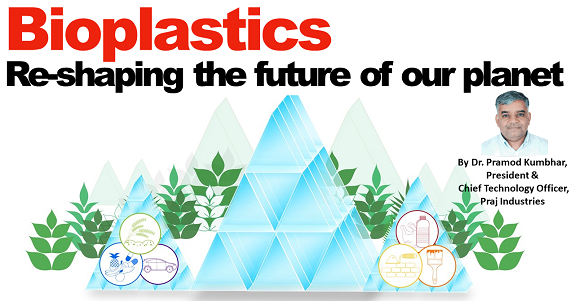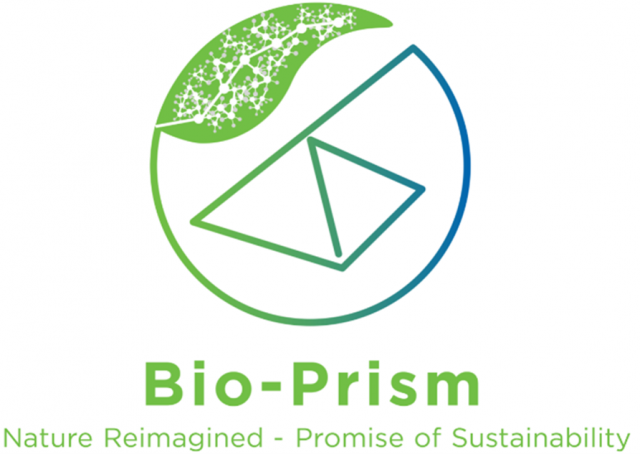Bioplastics: Re-shaping the future of our planet

By Dr. Pramod Kumbhar, President and Chief Technology Officer, Praj Industries
Special to The Digest
The landscape of plastics and drivers for sustainable solutions
As society moves towards sustainable development and a circular economy, one aspect which needs urgent attention is the use of plastic and plastic-based products. With multiple functions and excellent material properties plastic has become an almost ubiquitous material in our economy and daily lives.
According to United Nations Environment Program, the global production of plastics has crossed more than three hundred million tonnes. As per the research conducted by the Center for International Environmental Law, greenhouse gas (GHG) emissions from plastic could represent 10-13 percent of the entire remaining carbon budget by 2050. According to the fortune business insights report, 2021, the global plastic market is projected to grow from $439.28 billion in 2021 to $616.82 billion in 2028, at a CAGR of 5.0% in the forecast period, 2021-2028.
Plastic’s non-degradable nature and non-renewable materials origin is also causing severe damage to our environment. Processes like manufacturing, disposal, incineration, and recycling of plastic cause a vast amount of GHG emissions at different steps through the plastic value chain. Marine plastic litter caused by ocean spilling has caused a disturbance in the marine ecosystems by harming food chains. GHGs from plastic not only affect climate but also pose negative impacts on natural adaptations and resilience mechanisms.
To reduce plastic pollution, society must adopt a circular economy concept helping achieve sustainable development. Globally governments are implementing policies related to bans on single-use plastics. In May 2019, the European Union approved legislation to curb single-use plastic. The directive promotes circular approaches that give priority to sustainable and non-toxic re-usable products. The Indian government has also announced a ban on single-use plastic to reduce plastic pollution which will be effective from 1st July 2022. As the environmental consequences of plastic become increasingly apparent, new technologies and alternatives to fossil fuel feedstock for plastic production should be considered.
Bioplastics: A greener solution
Bioplastics are a sustainable solution to the impending plastic pollution crisis. They are produced from sustainable feedstocks. Bioplastics like polylactic acid (PLA), polyhydroxyalkanoates (PHA) are biodegradable. They can bring a significant reduction in carbon footprint as compared to traditional oil-based plastics. Among bioplastics, it is important to identify and differentiate key characteristics like biodegradability, compostability, material/chemical characteristics, the extent of disintegration in the environment, and ecotoxicity. Biodegradation primarily occurs due to the action of enzymes or microbes present in the environment leading to a reduction in the molar mass of biodegradable material. After primary degradation, the low molecular weight compounds can further disintegrate into carbon dioxide, methane, and cell biomass depending on the conditions (aerobic or anaerobic). According to the American Society for Testing and Materials (ASTM standard D6400), compostable plastic is “a plastic that undergoes biological degradation during composting to yield carbon dioxide, water, inorganic compounds, and biomass at a rate consistent with other known compostable materials and leaves no visually distinguishable or toxic residues.” Thus, compostability is a subset of biodegradability making most biodegradable plastics compostable. Today, a variety of materials are termed generally as “bioplastics” including “biobased and non-biodegradable”, “biobased and biodegradable” and “fossil-based and biodegradable”. Although several international bioplastic standards have been defined across the globe, further harmonization of different standards is desirable to set a universally accepted benchmark for biodegradability. Also required is a life cycle analysis-based approach which assesses the environmental impact of bioplastic constituents and degradation products.

*Plotted in reference to Elias HG. An introduction to plastics. Weinheim: VCH. Polymer international. 1994; 34(2): 237-238
Polylactic acid and Polyhydroxyalkanoates
In the last three decades, significant research and development have been done to develop technologies to produce both PLA and PHA. The global production capacity has increased beyond 300 Kilotons/Annum (KTA) and another 100 KTA capacity expansion is under progress. The demand for PLA has steadily increased beyond 190 KTA with greater than 60% demand coming from the packaging sector alone. It is estimated that by 2030 the potential demand for PLA may cross 600 KTA. As per the estimates by Nova institute among PLA and PHA at commercial scale, account for up to 19% and 2% of bioplastics respectively. From approximately 350 million tonnes of total plastics consumption, replacement of even 1% by bioplastics would require about 1.4 million tonnes of additional capacity. However, as compared to petrochemical-based plastics, the cost of bioplastics continues to remain a major challenge in further consumption and demand. Nevertheless, with continued thrust on sustainable development goals and global commitment for emission reductions government and large private sector organizations are adopting circular economy-based initiatives.
Bioplastics: Feedstocks, Technology, and Products
For any biobased product and technology, the selection of appropriate feedstock is critical for the successful scale-up and commercialization. In the case of PLA, both sugar and starch-based feedstocks are being used today to produce lactic acid. Production of high purity L-Lactic acid is critical for the polymerization process. Optically pure L (+) lactic acid is produced by fermentation of sugars by lactic acid bacteria or genetically engineered yeast species. The advantage of the yeast-based process lies in the direct production of lactic acid at lower pH. Bacterial production of lactic acid commonly involves the generation of by-product gypsum (calcium sulfate) which poses disposal challenges. Lactide to PLA polymerization proceeds through a ring-opening polymerization process catalyzed by an organometallic catalyst at high temperatures and under vacuum. This multistep process is commonly employed for PLA production despite challenges related to higher Capex and Opex related to a multi-step process. Today PLA is used in a variety of applications like packaging and food service ware and is increasingly favored for more durable applications in automotive, electronics, and textiles. PLA products with different molecular weights are available today. They are suitable in a variety of polymer processing applications like injection molding, fibre spinning, extrusion/thermoforming, and as a nucleating agent. PLA-based products comply with industrial composting standards (ASTM D6400, EN13432) and have been approved for food contact applications in the US, Europe, and China.
Polyhydroxyalkanoates: A deeper insight
Among biodegradable plastics, polyhydroxyalkanoates (PHAs) hold a unique distinction of being home compostable as well as complete degradation in the marine environment. Today, a variety of PHA-based polymers are available at a commercial scale including poly 3-hydroxy butyrate (P3HB) and copolymers like poly(3-hydroxybutyrate-co-valerate) (P3HB-co-HV), poly(3-hydroxybutyrate-co- hexanoate) (P3HB-co-HH), and poly(3-hydroxybutyrate-co-4-hydroxybutyrate) (P3HB-co-4HB).
PHA’s are produced by bacterial fermentation of renewable materials under nutrient-limited conditions. The intracellular PHA granules are extracted from bacteria by different extraction methods. With advances in synthetic biology and bioprocessing technologies, different types of PHAs can be produced with improved functional properties. PHAs are excellent candidates for a large variety of applications in thermoplastics, thermosets, elastomers, lubricants, glues, adhesives. They also find several non-traditional polymer applications like animal feed, cell regeneration in humans and animals, denitrification, and cosmetics. From a feedstock’s perspective, PHAs can be produced from a variety of raw materials including sugar and starch-rich feedstocks, pure and waste oils with high fatty matter content, and gaseous feedstocks rich in methane. The yield, titer, and productivity of PHA can be significantly impacted by the selection of feedstock and appropriate microbial platform, optimum fermentation parameters, design, and operation of fermenters. Further, the right selection of downstream processes can change the overall carbon intensity of the PHA product.
Compounding both PLA and PHA biopolymers has resulted in improvement in flexibility, thermal resistance, weather, and UV resistance. Fast nucleation from the melt, improved barrier properties, demonstrate that these hybrid PLA-PHA-based materials can be turned into a new series of super-polymers. These can be processed as fast as or even faster than the currently used polymers in the industry.
Considering the increasing plastic pollution crisis and the need for the adoption of a circular bioeconomy, new technologies providing sustainable solutions should be sought. Being a leader in the bioeconomy, Praj holds a unique position in industrial biotechnology with capabilities in technology development, engineering, design, and deployment of biobased products and technologies.
Moving to a sustainable world
The world is abuzz with themes like Sustainable growth, Circular Economy, Carbon-neutral/negative technologies, Recycling and Recovery, Responsible utilization of natural resources. These themes primarily revolve around more sustainable and low carbon-emitting renewable chemicals and materials (RCM). RCMs are the key to achieving the global commitment to accelerate climate action into reality. As a part of this initiative, the replacement of 1-5 % of plastics with bioplastics will have a significant impact on terrestrial and aquatic ecosystems thereby improving planet & human health. Future technological developments in new bioplastic materials, improving the functionality of bioplastics, and developing the entire ecosystem around bioplastics will pave the way to a greener world. Praj with the motto of “decarbonization through the circular economy,” is relentlessly working to support this global climate action plan by driving the development of the most competitive technology for bioplastics through its Bio-Prism portfolio.
The use of renewable chemicals and materials in all spectra of life has become an indispensable goal globally. The development of bioplastics is a pioneering step in attaining this goal and will define the future of the circular economy.

Category: Top Stories, Thought Leadership















